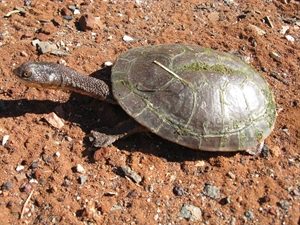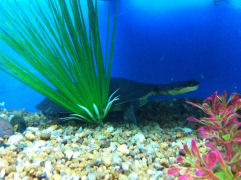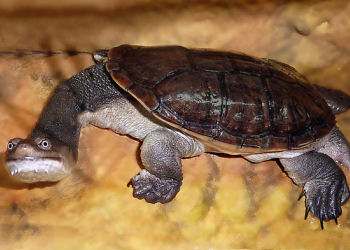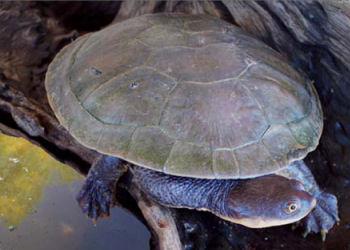Turtles

here are two beautiful turtle species that can be kept as pets in WA if you have obtained a suitable Reptile Keeper’s Licence. These are the Oblong turtle and Flat Shelled turtle. Turtles are reptiles that do have scales and are cold-blooded, most turtles spend much of their time in the water, tend to have webbed feet and are omnivores. Turtles have excellent eyesight and a keen sense of smell, they are fascinating to watch, making them popular pets for families and hobbyists alike. Did you know that turtles have been on the earth for more than 200 million years?
Housing
If you have a small or young turtle it may need to be kept indoors. An aquarium approximately 1 metre long is suitable. Cover the floor with large gravel, sloped upwards at one end so that a dry basking area is available. Large flat rocks at this end can also help. It is important that your turtle be able to get out of the water when it wants. Add water to a depth that is greater than the turtle is wide – it must be able to roll over completely without getting caught on the bottom.
For large adult turtles outdoor housing is preferable as it better suits their larger size and aquatic lifestyle. For good health, it is essential that both sunshine and shade are available to your turtle when in the water and on land. A pond with a walled enclosure is ideal just ensure there is plenty of shade during the summer seasons.
Feeding
Turtles can be voracious feeders on raw meat, insects, earthworms, crickets, small mice and fish. If using calcium deficient food such as raw meat regularly, it requires dusting with a calcium/vitamin supplement. Small fish such as Gambusia are perfect, and freshwater crayfish can sometimes be introduced to large ponds as a food source. They normally take food only in the water however, in time, they will take food from tongs or tweezers. Feed adults about twice per week, juveniles need more frequent feeding and much smaller food items: live water fleas (Daphnia), mosquito larvae and brine shrimp are ideal. Any uneaten dead food should be removed within an hour after offering. Food variety is very important for turtles, feeding your turtle solely on raw meat will cause a vitamin deficiency and possibly lead to death.
Water Quality and Temperature
Water quality must be strictly maintained. The pH needs to be kept between 7.4 – 8.0, and so a buffer may be needed. Change 25% of the water every week. If you have hard or acidic water, you may need to add 1 teaspoon of marine salt mix per 10 litres at each change. The water temperature should be maintained at 18° – 21°C.
Lighting
Turtles need a defined day/night cycle. For aquariums, UV light needs to be provided using UV lights for reptiles. Lights should be turned on and off at times corresponding to the day length outside. Allowing access to direct, unfiltered sunshine for 30 minutes each day can also assist in the overall heath of your pet turtle.
Handling
When handling a turtle, grasp the animal around the middle of the carapace and hold the animal away from your body . This method has two advantages. First, you will avoid the hind legs that have small claws that can cause minor scratching. Second, it is often at this point that the turtle will squirt liquid urine and faeces from its cloaca.
It is important to disinfect your hands after handling your pet and when performing maintenance within the enclosure, a clean environment is a healthy environment so remove all food and waste as soon as possible.
Common Health Risks
A clean artificial turtle environment with the appropriate conditions will usually result in your pets remaining healthy. That being said, nearly all disease problems of captive reptiles can be traced back to poor management. Nutritional deficiencies, skin conditions, parasitism, reproductive disorders, can be a result of management mistakes. Learning how to look after your reptiles before purchasing them is the best contribution you can make towards maintaining their health.
Quarantine newly acquired animals for at least a month before introducing them to those already being kept.
Things You Might Need
- Large Tank/Pond
- Heating and Heat Sources
- UVA and UVB Lighting
- Substrate/Large flat rocks
- Filter
- Logs/Terrestrial Plants

Species
Oblong Turtle

Category 3
The Oblong turtle has a very long, thick neck and is commonly found in permanent waterways of the far south west of Western Australia. Their head is strongly depressed and their carapace is very oblong in shape (hence the name). The Oblong turtle’s shell is not as hard as other members of the genus Chelodina. These turtles have only recently become available as pet so there little information gathered on their captive maintenance. Oblong turtles can be quite shy and can quickly develop stress related illnesses. It is important to offer your turtle adequate hiding areas. Maximum length 40 cm.
Flat Shelled Turtle

Category 4
The Flat Shelled turtle is also known as Dinner-plate turtle because of the round shape of its shell. It is the least known of the Australian turtles and also one of the smallest members of the long-necked turtle family. Flat Shelled turtles have a very placid nature and will settle into captivity very quickly and many become tame within a few days. Maximum length 20 cm.
